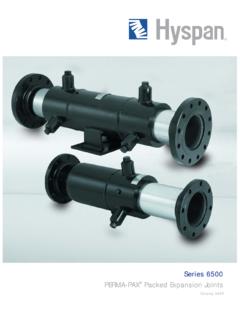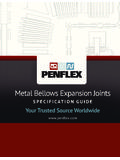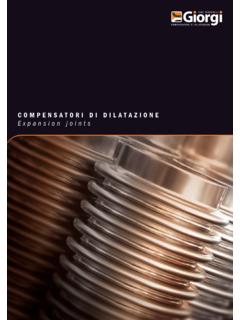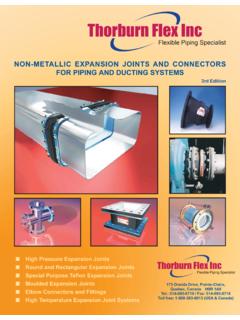Transcription of Expansion Joints - MEGAFLEXON
1 Expansion joint & FLEXIBLE PRODUCT. Expansion Joints Fabrication procedure Cutting of the thin bellows layers Rolling on roller bending machine Welding of the outer and inner layer Radiography & Liquid Penetrant test polishing Preparation of the and welded Multiply bellows, with inner and outer layer 4 welded layer 2ND. 1ST. Roll forming by wheel Multiply expension bellows or hydraulic powered forming after forming Edge Cutting Pneumatic test Hydrostatic test Heat resistant paint coating Weld attachment to the shell, or fittings 7. joint The selection of the optimum Expansion joint depends on a technical as well as an economical aspect. With many years of experience in design, production and marketing of Expansion Joints , we are competitive and specialized on the know-how on the solution for demand required in a technical and economical view. Therefore, it will always be highly appreciated to contact to us in case that you need our assistance.
2 We look forward to serving you. Engineering products, Expansion joint & flexible products, which can absorb thermal and mechanical movements in pipe-work and duct systems, provide solution to engineering problems all over the world. Application are as diverse as there are industries. There are applications in Process Engineering Power Generation Manufacturing Petrochemical Construction Cryogenic Metallurgy Nuclear Heating Ventilating and A/C. Aerospace Automotive Combustion Engine Bellows The bellows is the basic element of Expansion joint , which can be made by mechanical and hydraulic forming as the requirement in MEGAFLEXON facility. The mechanical forming, which is also known as roll forming, involves passing the tube through progressively deeper convoluted mandrels and gradually and cause realy fatigue failure by friction due to the concentration of local hardness. MEGAFLEXON can produce up to 8,000mm size as per the requirement. The hydraulic forming is a method in which forming tube is slowly compressed with low hydraulic pressure towards the inside after placing restraining rings around the forming tube and sealing both ends, and subsequently it leads to producing far better qualitive product than the 8.
3 Expansion joint & FLEXIBLE PRODUCT. mechanical forming does as it gives uniform hardening all over the world. In this method, MEGAFLEXON can produce up to 1,500 mm in nominal diameter. All bellows are formed in their cold state without heat treatment but it can be heat treated, in case that specially required. The physical capacity of bellows to absorb movement is determined by the number of corrugations, height (H), pipe diameter (D), spacing (L), radius (r), thickness of material (t), and number of layers (n). The basic constituent element of Expansion joint , bellows, can be specified, considering on movement, pressure, temperature, service life and corrosion rate required. Our standard material for the circular type bellows is austentic steel, that is, AISI. 304 and 316. In addition, other special Nickel based alloy material, like as Inconel, Incoloy, Monel and Hasteloy, can be applied on the servicing of agressive fluid. The below can be helpful for your consideration on bellows and other main part material of Expansion joint for the selection as per the specification required.
4 Basically, austenitic steel is resi- stant to both high temperature and a agressive media. It has a good mechanical properties as well when it comes to the effect of continuous motion in axial, lateral and angular direction. MEGAFLEXON bellows have been improved to achieve an optimized relationship between the various parameters, so that the bellows can withstand the greatest possible load without fail on normal operating condition. Basically, we carefully consider following criteria in designing bellows. a) The geometrically stable state in a hydro test pressure of times design pressure. b) The stability for a hydro-test pressure of x design pressure at least without permanent changes in shape of leaks develops. c) The reliable warranty service life of at least 7,000 cycles with nominal 9. movements and design pressure. d) Calculation for bellows designs are carried out to be in accordance with EJMA (Standard of the Expansion joint Manufacturers Association).
5 Edition. It is essential that the weld in the bellows be as strong as the surrounding material. Welding is done by qualified welders using machines specially built for the purpose. Welds comply with every metallugical requirement with regard to durability and strength, documented by the certified procedure test. thermal Expansion of pipe The extent of Expansion depends on the temperature difference, the Expansion coefficient and the length of the pipe. The Expansion coefficient varies from one material to another and is also dependent on the temperature, as it increase as the temperature rises. The coefficient list, graphical chart and calculation example are shown on the Reference Data. H. instruction for MEGAFLEXON axial Expansion Joints . Pipe laying On installing pipelines, care should be taken that the pipe is laid in a straight line. Fixing points should be located in such a way that the pipe expands correctly in relation to the type of Expansion joint chosen.
6 Guide Especially, to operate the Expansion joint effectively and positively, a guide pipe which slides smoothly with less friction should be provided between the fixing point and the Expansion joint . The distance between the Expansion joint and the guide adjacent therto should be determined to be L1, L2 shown in fig. Guide bearings Guide bearing, which protect the pipe-work against bending in all directions, should be of the slide or roller type. Pendent suspension is not recommended. Only one axial Expansion joint may be fitted between 2 fixing points. Guide bearing should be placed at the maximum intervals. 10. Expansion joint & FLEXIBLE PRODUCT. Fixing points, or main anchor Pipelines in which Expansion Joints are to be installed should be secured with fixing points. The fixing points must be sturdly enough to absorb the forces originating from the Expansion joint and the frictional resistance of the guide bearing. That is, stress on the main fixing point Fh is composed of the resulting forces coming from.
7 A) The spring constant Ca, which is the force it takes to move the bellows 1 mm axially or laterally. Since the spring constant is a theoretical cal- culation, a deviation of +- 30% from the values specified on the data sheets must be expected. b) Tensile stress from the highest operating pressure of P bar affecting the active area Ab mm2 of the bellows. Nominal Dia (mm). 80 100 125 150 200 250 300 350 400 450 500 600 800 1000 1200 1500 1800. L1 (m) L2 (m) 100. 100. L3 = EI 10-3 .. (37) 80. PA Fex 70. 60. L3 = Maximum intermediate quide space(M) 180. 0. INTERMEDIATE GUIDE SPACING L3(M). 0 50. 150 1200 0. 100. E = Young's modulus of pipe material(kg/mm2) 40. 800. I = Moment of inertia of pipe(mm4) 30. 600 500. P = Design pressure(kg/Cm2) 450 400 350. A = Bellows effective area(mm2) 300 250 20. F = Bellows initial spring rate per one 15. 200. corrugation(kg/mm/corr.) 150. 125. ex = Axial stroke of bellows per one 10. 100. corrugation(mm/corr.).
8 80. 5. When bellows is compressed in operation, use(+) F ex ;when extended, use(-) F ex . 30 25 20 15 10 7 5 4 PRESSURE(kg/cm2). 11. c) The inherent resistance of the Expansion joint , which is the product of the spring constant kgf/mm and the Expansion for the section of pipe. d) Addition for friction force from guides between two fixing points. Stress on intermediate fixing points Fm is calculated as the sum of the above stresses b) and c), since tensile stress for the same pipe dimension is entirely absorbed by Fh. Pre-stressing MEGAFLEXON standard Expansion Joints are dimensioned to absorb +/- movements from the neutral position of the bellows, with half being absorbed by each: +/- 20 mm = 40 mm total movement, +/- 7 Deg. = 14 Deg. total movement. It is possible to pre-stress the Expansion joint in order to make full use of the working range of the bellows. If calculation show that a total movement of 30 mm should be used, it is possible to use to advantage an ex- pansion joint with +/- 15 mm movement which has been half percent prestressed to = 30mm instead of an Expansion joint with +/- 30mm movement.
9 It should be noted, however, that it is not wrong to use an Expansion joint with a movement of +/- 30mm. The following parameters should be taken into account when verifying pre- stressing. 1) The overall dimensions at installation temperature 2) The neutral length of the Expansion joint before prestressing 3) The total movement of the Expansion 4) The highest operating temperature to occur 5) The lowest operating temperature to occur 6) The installation temperature It is very important that the Expansion joint is installed in its optimum position, as this will produce the best combination of movement and service life in the bellows. 12. Expansion joint & FLEXIBLE PRODUCT. of Setting Please take NOTE of the following matters with respect to the operation of Expansion joint . Removal of set bolt Expansion joint is provided with a set bolt or set bar that is painted yellows and used for adjusting dimension. Always remove this set bolt after piping in completed.
10 Inhibition of gas cutting of set bolt Always use wrench for removing the set bolt. Absolutely avoid gas cutting since if frequently may damage bellows. Protecting from welding spark Do not allow welding spark and grinder spark to come into direct contact with bellows. Always cover the bellows when you carry out these operations near the Expansion joint . Prohibition of arc in continuity test Absolutely avoid the contact of electrode and earth wire with bellows in the continuity test. Direction of flow Generally, the direction of flow is defined. Mount the joint in the direction of arrow. Take care where the direction of flow is not restricted, as is the case of hinged type, universal type, etc. Direction of mounting hinged type Particularly in the hinged type, hinge arm is mounted on both side of bellows. Hence, mount the hinge arm parallel to the direction of Expansion and contraction. Preset Generally the Expansion joint is set, taking the mounting temperature into consideration.







